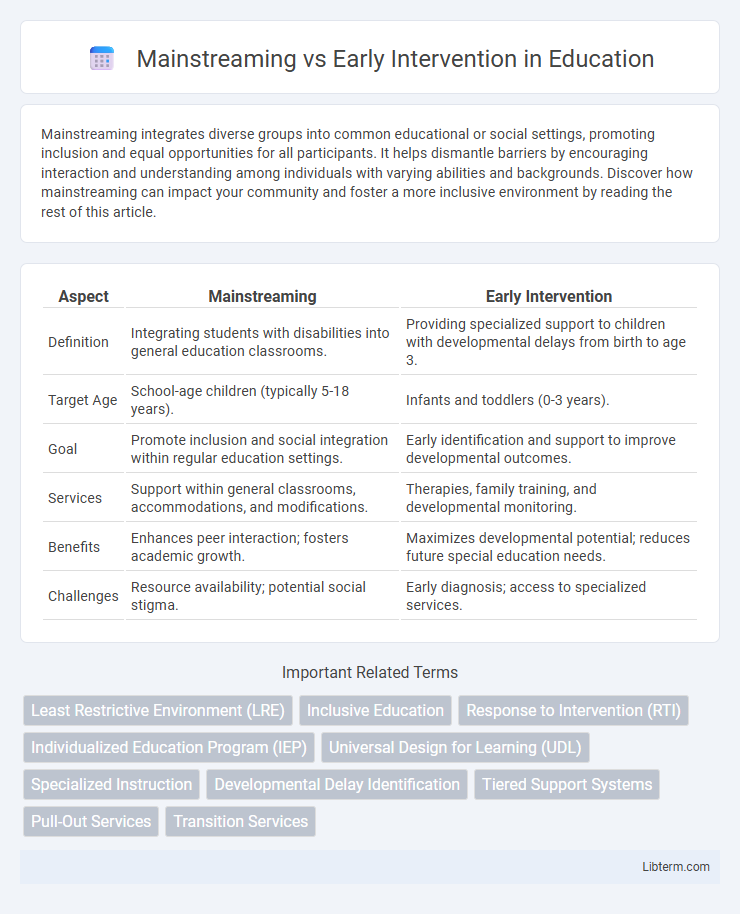Mainstreaming integrates diverse groups into common educational or social settings, promoting inclusion and equal opportunities for all participants. It helps dismantle barriers by encouraging interaction and understanding among individuals with varying abilities and backgrounds. Discover how mainstreaming can impact your community and foster a more inclusive environment by reading the rest of this article.
Table of Comparison
| Aspect | Mainstreaming | Early Intervention |
|---|---|---|
| Definition | Integrating students with disabilities into general education classrooms. | Providing specialized support to children with developmental delays from birth to age 3. |
| Target Age | School-age children (typically 5-18 years). | Infants and toddlers (0-3 years). |
| Goal | Promote inclusion and social integration within regular education settings. | Early identification and support to improve developmental outcomes. |
| Services | Support within general classrooms, accommodations, and modifications. | Therapies, family training, and developmental monitoring. |
| Benefits | Enhances peer interaction; fosters academic growth. | Maximizes developmental potential; reduces future special education needs. |
| Challenges | Resource availability; potential social stigma. | Early diagnosis; access to specialized services. |
Understanding Mainstreaming and Early Intervention
Mainstreaming involves placing students with special needs in general education classrooms to promote inclusion and access to the standard curriculum, fostering social integration and equal learning opportunities. Early intervention targets children from birth to age five with developmental delays, providing specialized support and therapies to improve long-term cognitive, social, and physical outcomes. Both approaches aim to enhance educational development but differ in timing, scope, and individualized support strategies.
Key Differences Between Mainstreaming and Early Intervention
Mainstreaming integrates children with disabilities into regular classrooms, promoting social inclusion and academic exposure alongside peers without disabilities, while early intervention targets developmental delays through specialized support services before school age. Mainstreaming emphasizes adapting the educational environment to accommodate diverse learners, whereas early intervention focuses on identifying and addressing developmental issues during critical growth periods to enhance future learning outcomes. The key difference lies in mainstreaming's goal of social integration within standard education settings versus early intervention's proactive approach to developmental challenges through tailored therapies and support.
Goals and Objectives of Mainstreaming Programs
Mainstreaming programs aim to integrate students with disabilities into regular classrooms to promote inclusion, equal access, and social interaction with peers. Goals include enhancing academic achievement, fostering independence, and developing social skills within a supportive general education environment. Objectives focus on individualized accommodations, collaborative teaching strategies, and ongoing monitoring to ensure meaningful participation and progress.
Core Principles of Early Intervention Strategies
Early intervention strategies prioritize early detection, family-centered approaches, and individualized support plans to enhance developmental outcomes for children with special needs. These principles emphasize timely access to therapeutic services, collaborative goal setting with families, and continuous monitoring to adapt interventions based on the child's progress. Mainstreaming complements early intervention by integrating children into regular education settings while ensuring appropriate accommodations and support.
Benefits of Mainstreaming in Educational Settings
Mainstreaming in educational settings enhances social integration by placing students with diverse learning needs in general classrooms, promoting peer interaction and reducing stigma. It fosters inclusive learning environments where students benefit from exposure to the standard curriculum alongside their peers, improving academic outcomes and self-esteem. Access to specialized support services within mainstream classrooms also enables tailored assistance without segregating students, ensuring equitable educational opportunities.
Advantages of Early Intervention for Child Development
Early intervention supports enhanced cognitive, social, and emotional development by addressing developmental delays promptly. It promotes better long-term educational outcomes through tailored therapies and specialized support during critical stages. Access to early intervention services increases opportunities for integration and improved adaptive skills, reducing the need for extensive special education later.
Challenges in Implementing Mainstreaming Approaches
Challenges in implementing mainstreaming approaches include insufficient teacher training and limited resources to support diverse learning needs within inclusive classrooms. Resistance from educators and parents often arises due to concerns about the adequacy of support for students with disabilities or special needs. Furthermore, systemic barriers such as rigid curricula and lack of individualized assessment hinder the effective integration of mainstreaming strategies.
Obstacles to Effective Early Intervention Services
Limited funding and insufficient trained professionals significantly hinder effective early intervention services, restricting access for many children with developmental delays. Complex eligibility criteria and fragmented service delivery systems create barriers for families attempting to navigate these programs. Cultural misunderstandings and lack of awareness further impede timely identification and support for at-risk children in early intervention settings.
Role of Families and Educators in Both Approaches
Families and educators play a crucial role in both mainstreaming and early intervention by fostering inclusive, supportive environments and addressing individual developmental needs. In mainstreaming, collaboration between families and educators ensures the adaptation of curriculum and classroom settings to accommodate diverse learners, promoting social integration and academic participation. Early intervention relies on close family involvement and interdisciplinary educator partnerships to identify developmental delays early and implement targeted strategies for optimal child outcomes.
Choosing the Right Approach: Factors to Consider
Choosing the right approach between mainstreaming and early intervention depends on the child's developmental needs, learning style, and social environment. Evaluating factors such as the severity of special needs, availability of support services, and family preferences ensures tailored educational experiences. Collaboration among educators, therapists, and parents is essential to optimize outcomes and promote inclusive growth.
Mainstreaming Infographic

 libterm.com
libterm.com